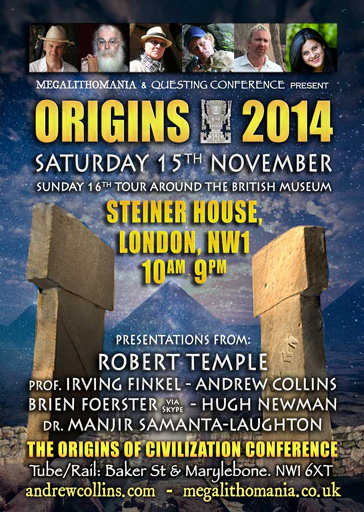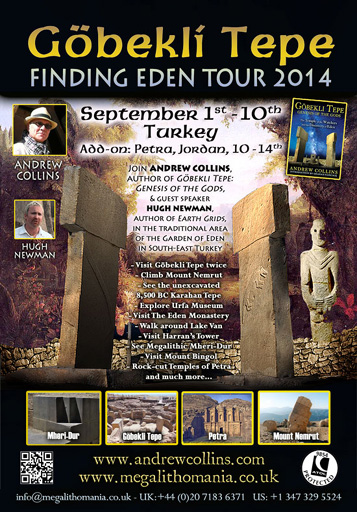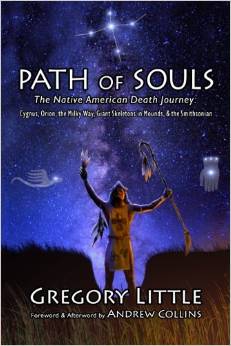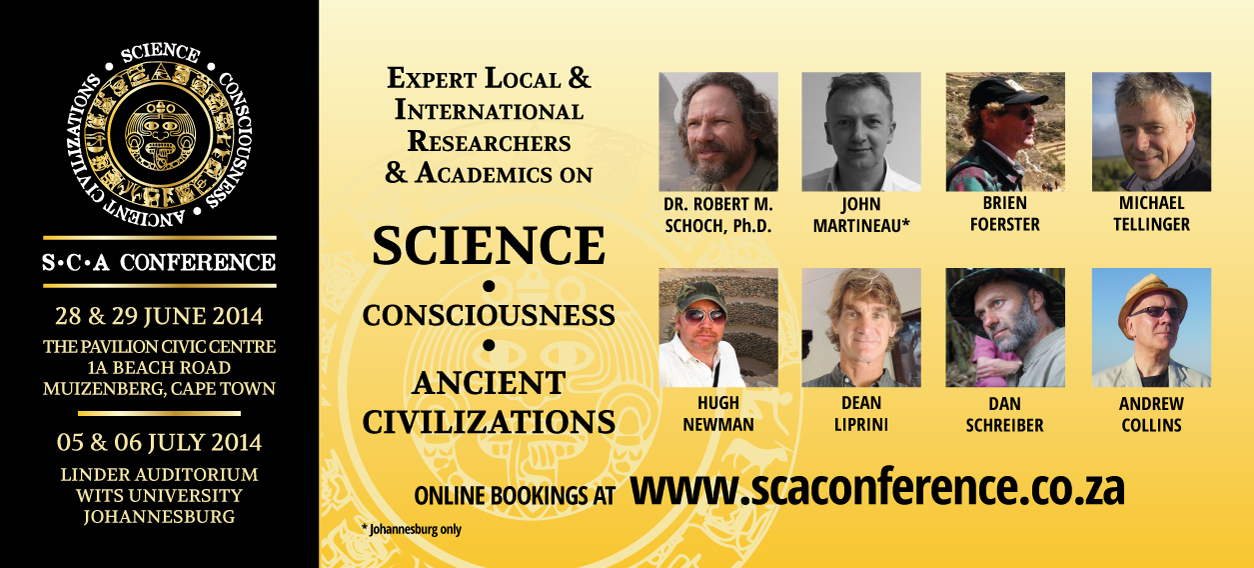E
a r t h Q u e s t N e w s
The
Andrew Collins Newsletter - June 2014
Andrew
measuring a standing T-shaped pillar at Karahan Tepe
In
this newsletter: the Launch of the Origins 2014 Conference in London this November—The
Origins of Civilization tour — A Brief Report on Göbekli Tepe’s
sister site Karahan Tepe — The upcoming Garden of Eden Tour to Eastern Turkey
in September — An appeal for information on upcoming tours — A new book
from Greg Little called Path of Souls with contributions from Andrew —
The upcoming SCA Conferences in South Africa.
London, Wednesday, June
17, 2014. I hope this newsletter finds you well. It is a while since my last
communication principally due to the fact that the publication of Göbekli
Tepe: Genesis of the Gods took up so much of my time, and then suddenly I was
on the flight out to Turkey with the Origins of Civilization tour. I returned
from this at the beginning of last week. More on this shortly.
Origins
2014 Conference Up and Running!
| First and foremost, Hugh Newman and I are proud to announce that the Origins 2014 conference is now up and running. Jointly organised by Megalithomania and the Questing Conference, it will take place on Saturday, November 15 at Steiner House, London NW1. Speakers include Professor Irving Finkel, who will talk about the recent discovery of a Mesopotamian cuneiform tablet that reveals an entirely new version of the Noah’s Ark story (the subject of his book The Ark Before Noah); Dr. Robert Temple, will revisit the Sirius Mystery in this unique presentation for Origins 2014; Brien Foerster, the American skull specialist, will deliver via video link his latest findings regarding the Paracas long-headed skulls of Peru, and the DNA evidence suggesting they belong to a human sub-species other than homo sapiens sapiens; Dr. Manjir Samanta Laughton, a black hole specialist and science writer, will argue that black holes have had a profound influence on the origins of civilization and human life spans; Hugh Newman will reveal the results of his survey of thousands of reports of giant skeletons found both in North America and in other parts of the world (it is the subject of a new book he has written with New England giants expert Jim Vieira to be entitled The Megalithic Giants: The Lost History of a Forgotten Race), and me, talking about human hybrids, their identification with the Watchers of the book of Enoch, their impact on civilization, and their relationship to the giant skeletons with double rows of teeth found across North America. |
This
last topic is something I look at in some detail within a lengthy foreword and
afterword I have contributed to a new book written by my colleague Dr Greg Little,
an expert on Native American mound cultures. More on this book below.
I
shall also outline my current work at Karahan Tepe, which by the time of the conference
in November will have been enhanced by a further visit to the site in September
and by the results of the detailed survey of the site I am doing with Rodney Hale.
Earlybird tickets for the conference are £45 per person. The Sunday
Walkabout is £14 per person.
For more information on all the speakers
and their presentations, and how to get tickets:
http://www.andrewcollins.com/page/conference/conferencenews.htm
The Origins of Civilization Tour
The Origins
of Civilization tour was quite extraordinary. In eleven days our group of eleven
visited a host of ancient and sacred places including the Neolithic cities of
As,?kl? Höyük and Çatal Höyük, the ancient city of
Konya (for the Whirling Dervishes ritual display), the beautiful Ilhara Valley
with its rock churches, the fairy chimneys and underground cities of Cappadocia,
the incredible Hittite and pre-Hittite centers of Alaca Höyük and Hattusa,
the now covered Göbekli Tepe, the mausoleum of Antiochus at Nemrut Dag(,
the tumulus of King Midas at Gordion, the birthplace of Abraham in S,anl?urfa,
the Sabian city of Harran, and many more besides.
A
Brief Report on Karahan Tepe
By far the most significant place
we visited on the tour was Karahan Tepe, Göbekli Tepe’s sister site.
Located in the Tektek Mountains, some 23 miles southeast of Göbekli Tepe
and around 30 miles southeast of Sanliurfa, it is an early Neolithic stone sanctuary
constructed on an elevated limestone hill ridge. From the type of stone tools
found scattered about the hilltop and in the valleys below, and the lack of ceramic
pottery fragments at the site, we can be pretty sure its main construction phase
was during the Pre-Pottery Neolithic B period, ca. 8700-6000 BC. Indeed, we can
pin down the time of occupation better by an examination of the T-shaped stone
pillars found at the site. They are similar in size and appearance to those seen
in the youngest structures at Göbekli Tepe (including Enclosure F and the
various cell-like rooms which contain stones no more than two metres high), which
are thought to date to ca. 8500-8000 BC, its final phase of construction. However,
the presence of a much larger, unfinished monolith still present in the bedrock
on the west side of Karahan Tepe (see below), indicates that even larger, and
thus much older, pillars might once have existed at the site (the general rule
at Göbekli is that the bigger and more sophisticated the pillar, the older
it is, with the earliest dating back to ca. 9500-9000 BC).
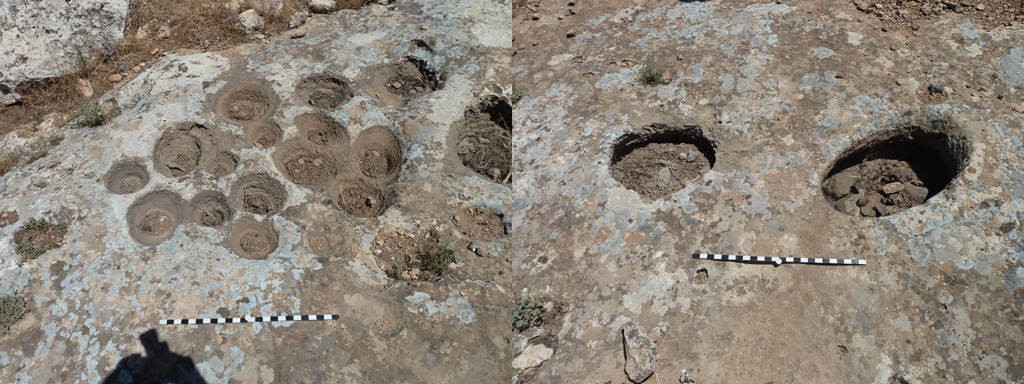
Left,
cupules in exposed bedrock on Karahan Tepe's northern knoll. Right, one of the
three sets of large twin holes that have the appearance of eyes staring out at
you. All examples are on Karahan's northern knoll.
What remains today at Karahan Tepe are the remnants of three stone avenues, originally made up of twin sets of T-shaped standing stones. These stones, some of which have either lost their T-shaped terminations or are still almost entirely buried below the ground, ascend in what appears to be a zigzag pattern toward an exposed area of bedrock located at the site’s northern extreme. The surface of this northern knoll, as I shall call it, is covered in cupules (bored cup marks) like those seen on exposed rock surfaces at Göbekli Tepe. In addition to this there are much larger holes bored into the bedrock, which appear in pairs, like dark eyes staring out at you. There is also a large cistern cut into the bedrock of Karahan’s northern knoll, similar to examples seen next to Göbekli’s Enclosure E, the so-called Rock Temple, where almost all of the site’s cupules are to be found.
Place
of the Snake
In almost every case only the heads of the standing
pillars are visible above Karahan’s covering of soil, which might well have
been imported from the surrounding valleys to cover the stone avenues at the end
of their useful lives. There is carving visible on the stems of some of the pillars,
including vertically cut sunken areas on the front narrow edge of at least two
examples. This replaces the vertically cut parallel lines seen on many of the
T-shapes found at Göbekli Tepe and also at Neval? Çori, although whether
these sunken areas are meant to represent the hems of garments, like they are
at Göbekli and Neval? Çori remains unclear. Probably is the answer.
Any stones found at the site with more intricate carving have already been
removed for safe keeping by Bahattin Çelik, an archaeologist and prehistorian
with Harran University. He discovered the site in 1997, and has conducted two
surveys here—one in 2000 and another in 2011.
One complete pillar,
along with the fragments of two others, were found to have a single, sperm-like
snake slithering down their front narrow edge. Because of this the snake has become
the most common zoomorphic form found carved on the stones at Karahan Tepe, and
so might well have had some significance to its builders. It is even possible
that the zigzagging pairs of stones making up the stone avenues located on the
northern, eastern and southeastern sides of the tepe signify the paths of snakes,
which are seen to descend, like living energy, into the valley below. This idea
is given credence through the fact that carving on the stones seems directed up
the hill, as if the direction of movement is downward through the various sets
of gateways (after coming to this conclusion I actually dreamt of snakes, their
tails tied together, each one trying to break free of its bondage, all of them
writhing about in the process. With this dream came the impression that the snakes
represented the containment, flow and energy of the stone avenues at Karahan Tepe—an
interesting concept if nothing else).
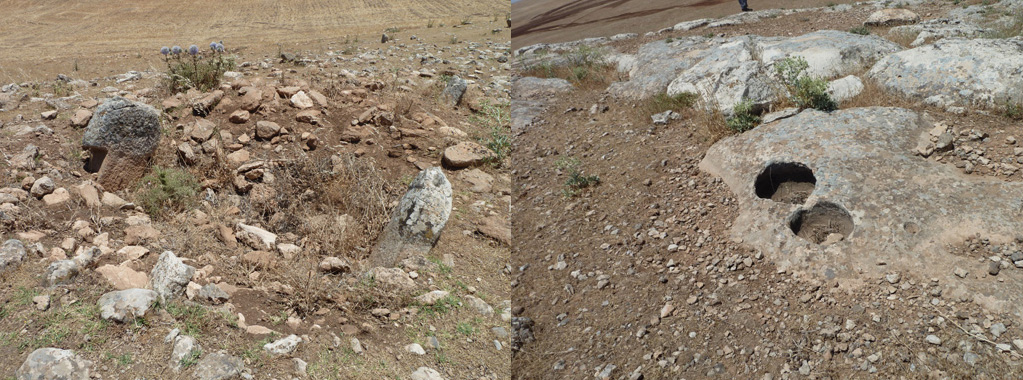
Left,
twin T-shaped pillars in Karahan Tepe's southeastern avenue, which ascends toward
the sanctuary's northern knoll. Another pair of twin holes on Karahan's northern
knoll. Note the ridge-like edge of the summit behind them.
Porthole Stones
Also seen on and around the north
side of the hill, and in the valley on its eastern side, were fragments of cut
and dressed stone, including right-angled pieces from what appear to be porthole
stones, like those found at Göbekli Tepe. If they really are porthole fragments,
then they would have formed either vertical or horizontal entrances into now lost
enclosures.
Karahan
Tepe possesses a curious ambience that conjures the vision of strange rites and
rituals from some forgotten age. Indeed, there is a strong sense of movement and
procession that is missing from Göbekli Tepe, where all the activity seems
to be centred around the interior of the enclosures. All this begs the question
of what exactly was going on here, and what purpose the northern knoll might have
served. It is a matter I am now exploring with the help of chartered engineer
Rodney Hale. Together we are looking at potential astronomical alignments, as
well as the spatial relationship between the various features seen at the site.
Since the ground rises up to the south behind the northern knoll the natural
inclination when standing here is to look north. Doing so takes the eye to a bare,
flat-topped hill or tepe located toward the north-northwest at approximately half
a mile distance from Karahan Tepe. I took the azimuth bearings of this rocky summit,
and was able to determine that during the site’s proposed epoch of construction,
ca. 8500-8000 BC, the observer standing on the northern knoll would have been
able to see the stars of Cygnus, and thus the Milky Way’s Great Rift, sink
down into the summit of this northerly tepe. It is thus likely that this prominent
rocky hill played some role in the horizontal cosmic geography of the Karahan
population, who presumably lived somewhere close by on the eastern fringes of
the Harran Plain (nearby is the great Sabian centre of Sogmatar, where tradition
asserts the seven planetary temples of Harran were located). Göbekli Tepe
is, of course, located beyond the northern limits of the Harran Plain.
Before
arriving at Karahan Tepe I asked our tour to try and explore every part of the
site and report any archaeology they came across in order that it might be photographed
and recorded. Although the location remains under the control of archaeologist
Bahattin Çelik and Harran University, visits like this can add immensely
to our understanding of the site, especially as artefacts I saw and photographed
when I first visited Karahan back in 2004 do not appear in Çelik’s
detailed report of the site published in 2011 (see http://arheologija.ff.uni-lj.si/documenta/pdf38/38_19.pdf).
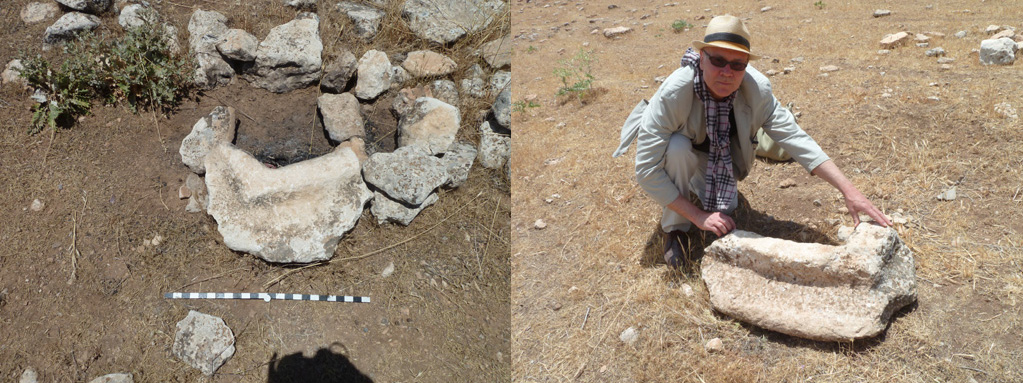
Left,
porthole fragment at Karahan Tepe on the hill's summit being used as as a fire
stone. This item is at least 10,000 years old, and is a work of art. Right, much
larger porthole fragment half way down the tepe's eastern slope. This one was
also photographed in 2004.
Unfinished
Monolith
What we did manage to locate was the unfinished monolith
mentioned in Çelik’s report. It lies on the hill’s western side,
just below an exposed northeast-southwest ridge that runs the entire length of
the hill. We were able to measure this gigantic pillar, which remains attached
to the bedrock, and found it to be 18 feet (5.5 metres) in length with an maximum
width of 6.6 feet (2 metres) across its T-shaped head. This is similar in size
to the twin monoliths at the centre of Göbekli’s Enclosure C and D.
Although no pillars this size are presently known to have been erected at Karahan
Tepe (the surviving examples, if fully exposed, would be no more than a couple
of metres in height), it does suggest that much larger, and thus far older examples,
could await discovery.
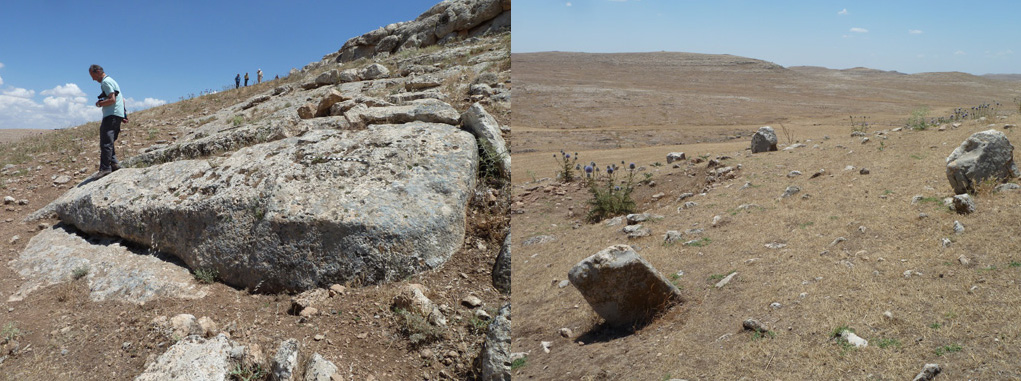
Left,
Karahan Tepe's unfinished monolith. It is 18 feet (5.5 metres) in length and 6.5
feet (2 metres) in width across its T-shaped head. Right, stones in Karahan's
northerly facing avenue.
The
Bald Place
Another interesting fact emerged during our visit to
Karahan Tepe. After leaving the hill we were invited to share the hospitality
of the site’s owners in their farmhouse. As our group sat around on colourful
padded cushions drinking black tea, I was able to ask the owner a number of questions
via our Turkish guide. Firstly, it seems that the importance of Karahan Tepe was
not realised by anyone until Çelik’s first visit in 1997. No folklore
or legends are connected to the site, although one important fact did emerge.
I knew already that the name “Karahan Tepe” was the creation of Bahattin
Çelik, derived from place-name elements of two local hills. The true name
of the tepe, it seems, is Keçili, which is also the name of the farm. Keçili
is a Turkish word meaning “goat”, which would make Keçili Tepe
the “hill of the goat”. However, the use of keçili in the place-name
here actually comes from the Kurdish root keç, meaning “bald.”
So in this instance Keçili means the “bald place,” with Keçili
Tepe implying the “bald hill,” an allusion to the fact that no grass
grows on the hill’s summit, just around its edges, giving it the likeness
of a man’s bald head (not very mystical, I know, but it is the truth of the
matter).
That the farm is also called Keçili, and is located on
a track that allows access to the hill from an east-west running road (of poor
quality), which curves around the aforementioned northerly-placed tepe, might
suggest that this track, and perhaps even the site of the farmhouse, dates back
to the age of Karahan Tepe.
Why exactly Bahattin Çelik chose to
ignore the site’s Keçili name, and instead called the hill sanctuary
“Karahan Tepe” remains a mystery. Maybe he didn’t think it gave
it an air of mystery, or, more likely, he was protecting the location from treasure
seekers who come here, usually at night, to try and steal away carvings and standing
pillars. Apparently, they try to gain the help of the farmer, who always refuses
to take part in their illegal activities. On one occasion these treasure seekers,
who are mainly local men, broke a carved pillar trying to remove it from the site.
What else they have found and removed is anyone’s guess, although the turned
over soil on the hill’s eastern side suggests they are determined to find
something of value here. All this is tragic and shows just how important it is
to record everything that is found at the site, before it disappears completely.
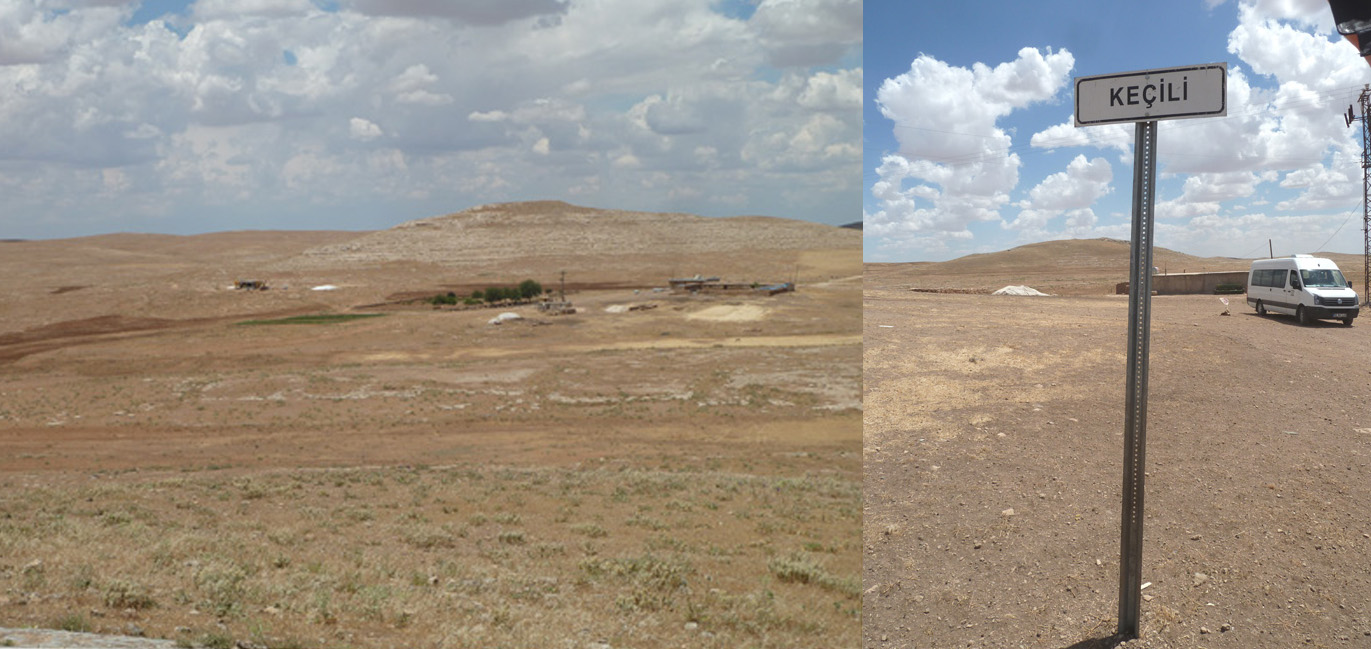
Left,
the northerly place tepe or hill to which the eye is drawn when standing on Karahan
Tepe's northern knoll. Note the presence of the farm below to the right. Right,
the sign showing the name of the farm, with the Keçili hill, also known
as Karahan Tepe, behind it.
Garden of Eden Tour
Clearly, there are
many mysteries to be unravelled at Karahan Tepe, and it is something I intend
spending time doing in the coming years. Hugh and I hopefully will return there
in September as part of the Garden of Eden tour, which begins on September 1st.
We would love you to join us out there.
| Sites to be visited on the tour include Göbekli Tepe, Harran, Sanliurfa, Çayönü, Nemrut Dag (both of them), Sogmatar, the Armenian church of Akhtamar on Lake Van, the plain of Mush and Armenian Highlands, which include the best candidates by far for the site of the Garden of Eden, the Mountain of God, and Mount Hermon, the Place of Descent of the Watchers, as well as the Fountain of Paradise at the Alevi shrine of Muska (where al-Khidr and Alexander the Great are supposed to have gained immortality). We go also to the Eden Monastery at Yeghrdut, where the Armenian monks not only believed they occupied some quiet corner of Eden, but also possessed what they saw as a piece of the Tree of Life, as well as the container in which were the dregs of the terrestrial form of the Oil of Mercy said to ooze like sap from the Tree of Life. This precious oil could supposedly bestow immortality on any living thing that came into its presence, while a visit to the monastery itself could make a person younger by as much as twenty years, the reason why Moslems and Christians alike came here from all over the region to seek healing and rejuvenation. This incredible site, located on the slopes of the Eastern Taurus Mountains, overlooks the plain of Mush through which passes the River Euphrates, one of the four rivers of Paradise. |
There
is even a token source of the Euphrates at Yeghrdut, which once appeared from
beneath an “evergreen” tree, where the above-mentioned artefacts were
apparently found in the fourth century of the Christian era (I gave away small
fragments of this tree with the special edition of Göbekli Tepe: Genesis
of the Gods).Clearly, if you want to join Hugh and I on this trip of a lifetime,
then just take a look at the newly revised itinerary at the following link.
http://www.andrewcollins.com/page/articles/origins_tour_0914.htm
I also attach the flyer. There is an additional four-day extension to Petra
in Jordan, which you can join at the end of the journey through eastern Anatolia
(or you can come on this separately if you wish).
I know there are a lot
of problems in places like Ukraine and Iraq at this time, but Turkey is another
country altogether, and you would never have any worries about safety here.
Göbekli Tepe: Genesis of the Gods
If
you want to better familiarise yourselves with the sites featured in the Garden
of Eden tour then I would recommend reading my new book Göbekli Tepe: Genesis
of the Gods. The first half is about Göbekli Tepe—who built it, when
and why. The second half is a personal quest to understand Göbekli’s
relationship to the stories of the Watchers and Nephilim, the Anunnaki of Mesopotamian
tradition, and, of course, the story of Adam and Eve in the Garden of Eden. It
eventually takes me to Yeghrdut’s Eden monastery, which had previously escaped
the attention of the ancient mysteries subject.
For a run down of the
book’s contents, see the following link:
http://www.andrewcollins.com/page/articles/Go_Tep_launch.htm
The book is available now in all formats either from me, or from Amazon, Barnes
and Noble and Foyles of London.
An Appeal
As
you know I have been working alongside Hugh Newman and Megalithomania for the
last year creating unique tours to Turkey. So far we have done two successful
Origins of Civilization tours, and have planned the Garden of Eden tour for September.
We also intend planning others further afield in the coming year or so. Obviously,
we look forward to seeing some of you out on these tours. However, I need feedback.
If you have not been on any of these tours, I want to know why. Are they simply
too costly? Do you not want to go to Turkey? Are you not interested in many of
the sites we visit? In addition to this, I need to know what type of tour would
you go on? What would be its destination? How long would it be, and what would
you expect to see, and visit? What countries are top of your list for the ultimate
pilgrimage experience? Let me know, even if you have to write anonymously. Hugh
and I are looking to make plans for the future, and we want to know how to make
these tours appealing to as many people as possible. Thank you.
Path
of Souls — A New Book from Greg Little
A while back my
friend and colleague Greg Little asked me to contribute to a book he was writing
on the origins of Native American star myths. The premise was this: recently,
various academic books and papers have outlined the view that the sky myths and
star lore of between thirty to forty different tribes were derived from a more
formalised idea of the journey of the soul in death used by what is known as the
Southern death cult, which flourished during the Mississippian period, ca. 800
AD and 1500 AD. This was a huge collective of mound building peoples focused around
key ritual centres such as Moundville, Alabama, and Cahokia, Illinois. Known to
academics today as the “Southeastern Ceremonial Complex”, these people
produced incredible examples of carved art in shell, stone and ceramics, much
of it bearing recurring iconographic themes that are almost certainly cosmic in
nature.
Central to the cosmic geography of the Southeastern Ceremonial
Complex, which inherited at least some of its religious iconography from earlier
mound building cultures such as the Hopewell and Adena peoples, is the Milky Way,
known to later tribes as the Path of Souls. In addition to this, two constellations
acted together to form cosmic gates that allowed entry into the afterlife. The
first was Orion, represented by an upturned, severed hand on the palm of which
was an eye-like device known as an ogee (actually a split in the fabric of reality),
and the other was Deneb, the brightest star in Cygnus, the celestial bird, which
was personified as a raptor bird known as Brain Smasher.
Orion enabled
the soul access to the Path of Souls, while Deneb became the judge of the dead
(a role it plays also in the Baltic countries and in ancient Egypt). If the soul
was deemed righteous enough, and free of sin, it was allowed to cross a log bridge
that spanned the void of space (which in actuality was the longest arm of the
Milky Way’s Great Rift). From here the soul of the deceased could enter the
afterlife proper.
These ideas feature in Gobekli Tepe: Genesis of the
Gods, although Greg felt he wanted to write a book on the subject, and asked me
to contribute a section outlining the importance of Cygnus, along with its relationship
to Orion (in ancient Egypt, for example). I readily agreed, although the resulting
work is far removed from the originate concept, for Greg wanted to include new
evidence of giant skeletons found at various sites associated with the Southern
Ceremonial Complex—sites that we investigated on my visit to the United States
in January and February. Indeed, we conducted a considerable amount of work to
try and determine the authenticity of these reports, many of which we found were
simple misinterpretations of normal sized skeletons, or else deliberate hoaxes
created by land owners wishing to draw attention to their estates. On the other
hand, we did find overwhelming evidence of very real giant skeletons being found
by excavators appointed by reputable institutions such as the Smithsonian, and
on visiting the sites, and speaking to archaeologists, we found more evidence
to back up the stories being told.
So while Greg outlined the star myths
of the Southern Ceremonial Complex, and the best evidence for the discovery of
giant skeletons, I set to work writing about the relationship between Orion and
Cygnus in ancient cosmologies, and how there was every reason to conclude that
these myths and traditions were of Paleo-Asiatic origin. In other words, they
existed first on the Eurasian continent during Paleolithic times and were then
transmitted to the American continent by incoming peoples prior to the sinking
of the Beringia land bridge sometime around 8500 BC. Even more incredible is that
there is now DNA evidence to back up this line of transmission from Central and
Eastern Asia to the American continent. Moreover, at least some of the Native
American elite groups that preserved this knowledge were of exceptional size,
as much as seven and a half feet tall, and derived most probably from populations
previously existing on the Eurasian continent.
| I
then looked into the matter of who exactly these individuals of exceptional size
might have been, and found compelling evidence that they were human hybrids, most
likely an admixture between the recently discovered human sub-species known as
Denisovans and Archaic Modern Humans (anatomical evidence of Denisovans was first
found in the Denisova Cave within the Altai region of Siberia in 2010). In conclusion,
it would seem possible that Native American star myths involving the Milky Way
as the Path of Souls, and Cygnus and Orion as gateways to the afterlife, might
well have been carried on to the American Continent in Late Paleolithic times,
ca. 15,000-8500 BC, by groups that included human hybrids of exceptional height,
who were also of quite striking appearance. All of these findings and conclusions are outlined in the foreword and afterword to Greg’s book (my contribution amounts to just over 12,000 words in all) the full title of which is Path of Souls: The Native American Death Journey: Cygnus, Orion, the Milky Way, Giant Skeletons in Mounds, & the Smithsonian. It is published this month by Archetype Books of Memphis. |
I
shall soon be selling special copies of the book signed by Greg and myself, which
will be made available on the bookstore at www.andrewcollins.com. In the meantime,
material copies and an e-version of Path of Souls are available from Amazon.com
at the following link:
http://www.amazon.com/Path-Souls-American-Skeletons-Smithsonian/dp/0965539253/ref=sr_1_1?ie=UTF8&qid=1403011876&sr=8-1&keywords=little+path+of+souls
South African Conferences
That’s about it for now. Remember
also that I shall be attending the SCA Conferences at Cape Town on June 28/29
and Johannesburg on July 5/6. Other speakers include Robert Schoch, John Martineau,
Brien Foerster, Michael Tellinger, Dean Liprini and Dan Schreiber. For all information
and ticket registration go to the following link:
http://www.scaconference.co.za
ON
SALE NOW | 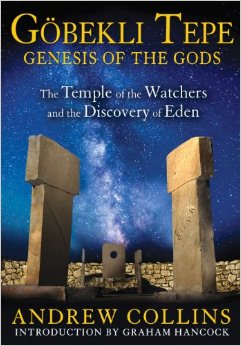 |
![]()
